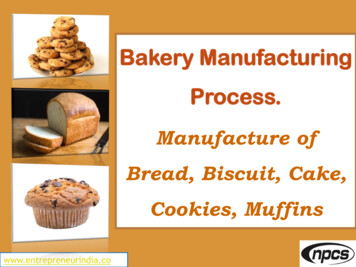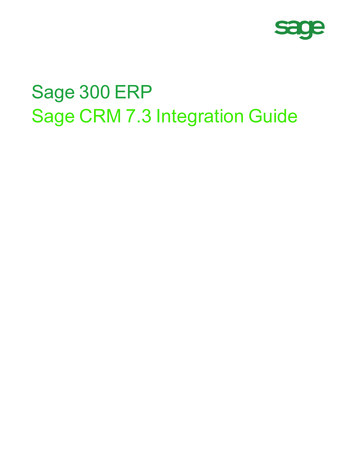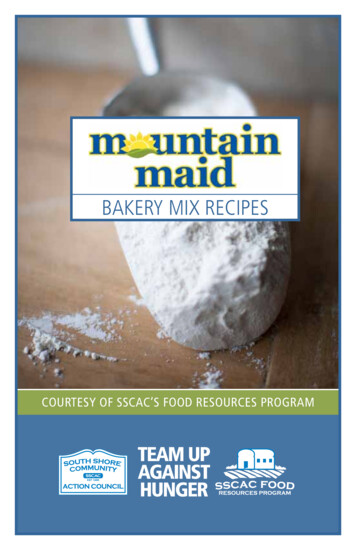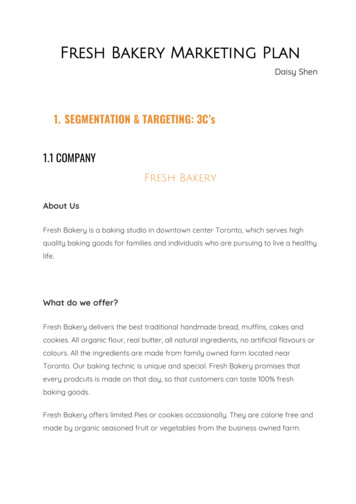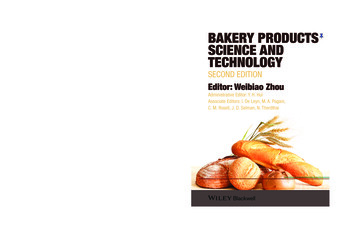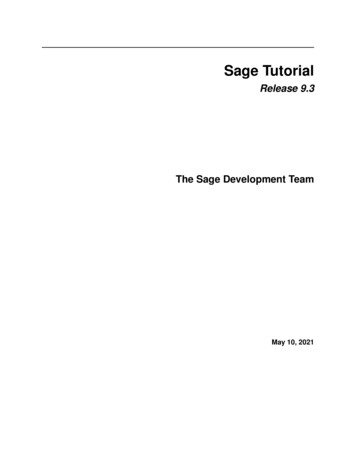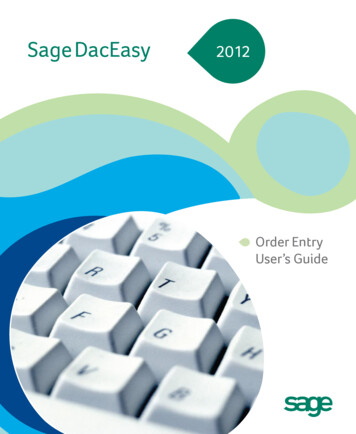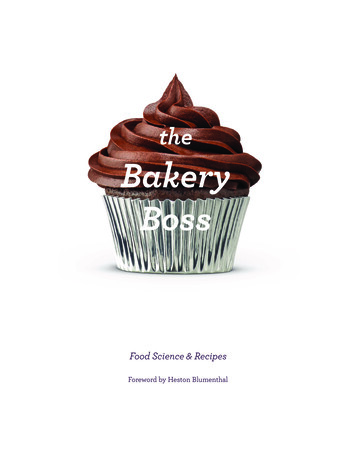
Transcription
theBakeryBossFood Science & RecipesForeword by Heston Blumenthal
Heston Blumenthal is world renowned for hisMichelin starred The Fat Duck restaurant,and pioneering multi-sensory dining. As a selftaught chef, his creativity and passion for sciencehave led to him to become one of the world’sleading culinary masters.His ethos is to question everything and he isknown for pushing the boundaries of traditionalcooking and pioneering new culinary techniques.His award-winning restaurants celebrate notonly his multi-sensory approach to the diningexperience, but also his relentless research intonostalgia and historic British gastronomy.His drive to bring new technology, science andgreater understanding into his cooking have ledto his work with many universities and becominga Fellow of The Royal Academy of CulinaryArts and The Royal Society of Chemistry.He has also been named by the RSC as one of the175 Faces of Science. Alongside his restaurants,Heston has numerous successful TV showsand cookbooks. He was also awarded an OBE(Order of the British Empire) for services toBritish Gastronomy.
One of the keys to a great cake is texture. Often whatyou’re going for is something light and airy, and for thisyou need lots of air in the mixture.How to get that airiness?The secret’s in the mixing.With traditional mixers, all too often the batter ends upsticking to the sides of the bowl, leaving lumps insteadof a smooth consistency. To combat this, the Sage BakeryBoss comes with a scraper mixer that wipes the sidesand bottom of the bowl with every turn. So it mixes fasterand more efficiently, incorporating plenty of air into thebatter to give you just the light, springy texture you’relooking for.Your Sage Bakery Boss is a great piece of kit for creativity,and no doubt you can’t wait to get in the kitchen and try itout. The accompanying book will help you do just that: it’sfull of essential info about the 5 core ingredients of baking,plus a bunch of delicious recipes for you to playaround with.Well, what are you waiting for? Show the Sage BakeryBoss who’s boss – and get baking!
Now lets mix upsome magic.
6.EggsThe Fresh Egg TestRicotta PancakesMocha Mousse CakeFree-Form Apple, Rhubarb & Crumble TartChocolate Chip Ice Cream SandwichesSalted Caramel Ice CreamFlourFlour Food ScienceQuinoa Linseed & Chia BreadCinnamon ScrollsGingerbreadFresh Pasta DoughPizza Dough18.SugarMore Than a Sweet ToothMini Blood Orange CheesecakesLittle Lemon Meringue CakesPavlovaLemon ShortbreadCoconut MarshmallowsLeavening AgentsThe High RiseApple Tea CakeRed Velvet CupcakesCarrot Cake with Cream Cheese FrostingCaramel Chip Peanut Butter CookiesQuick Bread30.12.ButterThe Cream of the CropRaspberry CupcakesPassionfruit Yo Yos'Citrus TartChocolate Molten CakeChocolate Brownie Cheesecake24.
The Fresh Egg Test.Small air cellLarge air cellFresh eggs lay on their sideand are best for bakingOlder eggs float on their endand are best saved for scrambled eggsEggs can affect a recipe in a range of ways, dependingon how they are treated. What other ingredient couldemulsify, aerate, bind, leaven, thicken, and set mixtures?No ingredient is so versatile, in fact to find an alternative,you would have to turn to a range of ingredients likepotato starch flour to bind, baking soda to leaven, agar tothicken, and soy milk to glaze.When egg whites are whipped, the structure of the proteinunfolds and they orientate around the small pockets of airto create a uniform foam structure. Fats, including the fatsin the yolk, will prevent the white from reaching its fullvolume, so it’s important to separate without breakingthe yolk. The whisk and the bowl also need to be freefrom moisture or residual fats, and plastic bowls shouldbe avoided.As the foam is approaching readiness, it will start to lookshiny. Stop and check if stiff peaks have formed. Watch thefoam closely, as it will collapse if over-whipped, and it can’tbe reversed.6Sage TIPBefore using an egg for baking, it's a good idea to checkif it's fresh. As eggs age, the size of the air cell grows.Put the raw egg into a bowl of cold water deep enough tocompletely cover it. If it rolls around on the bottom, it’sfresh and good for baking. If it stands up on its point, it’solder and is best saved for scrambled eggs for breakfast.If it rises to the surface, it is too old to use.The Bakery Boss comes with a whisk that is essentialfor giving egg whites the desired 'stiff peak' structure.Begin by using the KNEADING setting to start mixingand then slowly work your way up to the WHISKINGsetting. The glass bowl makes it easy to see theconsistency of the peaks. Just be careful not to over-beatas beautifully stiffed peaks and turn grainy and dull.
Ricotta PancakesPrep 15 minutes / Cook 15 minutesServes 8–103 eggs, separated2 tablespoons caster sugar200g fresh ricotta½ cup (125ml) milk¾ cup (110g) self raising flour1½ teaspoons baking powderUnsalted butter for greasingFresh berries, to serveMaple syrup, to serveMethod1. Assemble mixer using the whisk attachment. Add egg whitesto mixer bowl. Turn the mixer to AERATE/WHIP setting andwhisk egg whites until soft peaks form. Add sugar and whiskfor 1 minute. Transfer egg white mixture to another bowl.2. Place egg yolks, ricotta and milk into bowl of mixer.Still using the whisk attachment, turn the mixer toCREAMING/BEATING setting and mix until combined.Reduce speed to FOLDING/KNEADING and add siftedflour and baking powder and mix until just combined.Return egg white mixture back into mixer bowl and mix onFOLDING/KNEADING setting until just combined.3. Heat a heavy base frying pan or griddle over a low tomoderate heat. Lightly grease with butter.4. Spoon about L cup of the mixture into pan and cook untilgolden brown on both sides.5. Serve with fresh blueberries and maple syrup.TipFor berry pancakes pour mixture into pan; top with several freshberries before flipping over and cooking other side.7
Mocha Mousse CakePrep 30 minutes / Cook 5 minutesMakes 12350g dark chocolate, chopped130g butter, chopped1 tablespoon honey200g digestive biscuits4 eggs, separated, at room temperature300ml thickened cream30ml strong espresso coffee, chilledCocoa powder, to dustChoc curls, to serveMethod1. Line the base and sides of a 22cm (base measurement)springform pan with baking paper.2. Place 50g of the chocolate, 100g butter and honey in aheatproof bowl over a saucepan half filled with simmeringwater (making sure the bowl doesn’t touch the water).Stir with a metal spoon until melted and smooth.Remove from heat.3. Place biscuits into a food processor or blender and processuntil finely crushed. Add to chocolate mixture and stir tocombine. Spread over the base of prepared pan. Place infridge for 30 minutes to set.4. Meanwhile place remaining dark chocolate and butter in alarge heatproof bowl over a saucepan of simmering water(making sure the bowl doesn’t touch the water). Stir with ametal spoon until melted and smooth. Remove bowl and setaside for 5 minutes to cool slightly.Stir in egg yolks until combined.5. Assemble mixer with the whisk; add egg whites to mixerbowl. Slowly turn mixer to AERATE/WHIP setting and beategg whites until firm peaks form.6. Assemble mixer with the scraper whisk and the small mixerbowl. Place cream and coffee into bowl and attach thepouring cover. Slowly turn mixer to CREAMING/BEATINGsetting and beat for 1–2 minutes or until just thickened andvery soft peaks form.7. Add half the cream mixture to the chocolate mixture and stiruntil combined. Gently fold through half of the egg whitesand mix until it is combined. Repeat with the remainingcream mixture and egg whites. Spoon mixture over biscuitbase. Smooth surface. Cover with plastic food wrap.Refrigerate for at least 8 hours or overnight, until set.8. Just before serving release cake from the springform panand peel away baking paper. Place cake onto a serving plate.Dust with cocoa powder, top with choc curls.8
Free-Form Apple,Rhubarb& Crumble TartPrep 30 minutes / Cook 30 minutesServes 6–8Sweet shortcrust pastry1¼ cups (185g) plain flourL cup (55g) icing sugar¼ cup (30g) almond meal125g butter1 egg yolk1–2 teaspoons cold waterCrumble¼ cup (55g) brown sugar¼ cup (40g) blanched almonds½ teaspoon cinnamonL cup (30g) rolled oats50g cold butter, cubedFilling3–5 stalks (180g) rhubarb, sliced2 tablespoons white sugar2 granny smith apples, peeled, sliced1 egg white, lightly beaten2 tablespoons Demerara sugar, to sprinkleMethod1. Preheat oven to 200 C.2. Assemble the mixer with the scraper paddle. Add flour,sugar and almond meal and butter into mixer bowl.Slowly turn mixer to FOLDING/KNEADING setting andmix until it resembles sand like texture; add egg yolk andwater (if needed) and mix until pastry combines.3. Remove pastry from bowl onto a clean surface and shapeinto a flat disc. Cover pastry with plastic wrap andrefrigerate for 30–40 minutes.4. Meanwhile process sugar, almonds, cinnamon, oats andbutter in a food processor. And pulse mixture until roughlycombined. Set mixture aside.5. Toss rhubarb in white sugar set aside.6. Roll pastry out to a 35cm circle between two sheets of bakingpaper. Remove top sheet of paper and slide pastry onto abaking tray. Place half of the crumble into middle of circle.Top with apples then rhubarb. Sprinkle with remainingcrumble. Bring edges up around filling leaving top open.Brush pasty lightly with egg white and sprinkle withraw sugar.7. Bake in oven for 30–45 minutes or until golden.8. Serve warm with custard or ice cream.9
Chocolate Chip Ice Cream SandwichesPrep 40 minutes / Cook 10–12 minutesMakes 16Quick mix vanilla ice cream1 cup (250ml) pouring cream1¼ cups (310ml) whole milk¾ cup (185ml) sweetened condensed milk1 teaspoon vanilla extractCookies160g unsalted butter, softened¾ cup (150g) caster sugar¾ cup (150g) firmly packed soft brown sugar1 teaspoon vanilla extract2 eggs2 cups (300g) self raising flour150g dark chocolate, finely choppedMethod1. To make ice cream: Place cream, milks and vanilla into alarge jug and stir to combine. Refrigerate until cold.2. Assemble mixer with the pre-frozen ice cream bowlattachment. Turn mixer to FOLDING/KNEADING settingand pour ice cream base into ice cream bowl. Churn icecream for about 15 minutes or until firm.3. Transfer ice cream to a shallow tray; cover and freeze fora further 2–3 hours in freezer.4. Preheat oven to 200 C. Line two baking trays withbaking paper.5. Meanwhile to make cookies, assemble mixer with thescraper blade and the large mixer bowl. Place butter, sugarsand vanilla into bowl. Slowly turn mixer to CREAMING/BEATING setting. Beat for 1 minute. Reduce speed and addeggs, one at a time, and beat until combined. Reduce speedto FOLDING/KNEADING setting and add flour; beat untiljust combined. Stir through chocolate.6. Roll heaped tablespoons of dough into balls. Place ontotrays about 10cm apart. Bake in oven for 10–12 minutes oruntil lightly golden. Cool on trays for 2–3 minutes beforetransferring to a wire rack. Repeat with any remainingcookie dough.7. Once ice cream is firm but not too hard and cookies arecompletely cool place a scoop of ice cream onto one cookieand top with another cookie. Press lightly to squash together.Wrap each sandwich in plastic wrap and freeze for3–4 hours or until firm.TipFor fastest results when making ice cream allow the ice creambowl attachment to freeze for at least 24–48 hours before using.Allow longer in hotter weather or if fridge and freezer areopened often.* Ice cream freezer bowl accessory sold separately.Store bought ice cream can be used.10
Salted CaramelIce CreamPrep 15 minutes / Cook 15 minutesMakes 1L1½ cups (375ml) milk7 egg yolks¾ cup (165g) white sugar300ml pouring cream¾ teaspoon fine sea saltMethod1. Place milk into a medium heavy-based saucepan.Heat until milk just starts to simmer.2. Meanwhile, turn mixer to CREAMING/BEATING settingand beat egg yolks for 2 minutes, until pale and thickened.Once milk is hot, slowly whisk the milk into the eggs.Set aside.3. Combine sugar and water in a saucepan and stir over lowheat until the sugar has started to dissolve. Increase heatto a medium-high heat. Using a pastry brush dipped inclean water, brush down sides of saucepan with a clean, wetpastry brush to dissolve any sugar crystals and cook withoutstirring until the toffee starts to turn a rich golden colour.Remove from heat and carefully pour in cream.Note1. Mixture may splatter at this stage.2. Return mixture to a low heat and stir until any lumps havedissolved. Add egg mixture and salt and cook, stirring untilmixture coats the back of a wooden spoon.3. Pour mixture into a heatproof bowl, cover and refrigerateuntil well chilled.4. Once chilled pour into ice cream bowl. Set ice cream makerto desired setting and churn.5. Once mixture is frozen transfer to a freezer safe containerand freezer for up to 1 week.11
Doughs and don’tsMoist andcrumblyPastry has tight,unattached glutens encased in butterFlour is an intriguing and versatile ingredient. It is quiteincredible how foods with such dramatically differenttextures like crumbly shortbread, compared with a fluffycroissant, a quiche crust or a bread roll, all build theirstructure using flour.While the ingredients you mix with flour plays a part,the order in which you add them and the way you combinethem is far more important. It’s this that determineshow much the glutens (the proteins that give dough itselasticity) are developed.The structure of any dough is essentially determined byhow liquids (water or milk) and flour react to one another.The length of time the dough is kneaded as well as theamount of time the gluten in the flour is in contact withliquid is what determines the elasticity of the glutens andhence the dough. Bread dough needs wet flour, heavykneading and a decent proving time, to maximise itselasticity. But for a crisp, flaky pastry, the opposite is trueand gluten development needs to be kept to a minimum.This means adding the fat to the flour before any liquid toform a moisture barrier around the glutens.12Elastic andspongyDough has elastic,entwined glutensThe Bakery Boss loves making dough – a lot of dough.The high powered motor combined with extra sturdyconstruction, the Bakery Boss can make enough doughfor two large loaves of bread. The specially designeddough hook pushes the dough down into the mixing bowland kneads it with high pressure against the bowl wall,while the bottom hook folds and brings dough ball backup to the top of the dough hook to repeat the kneadingcycle. Fast, capable, and very easy.
Quinoa, Linseed &Chia BreadPrep 10 minutes / Cook 30–35 minutesMakes 1 loaf1 tablespoon black chia seeds1 tablespoon linseeds2 teaspoons white quinoa2 teaspoons red quinoa1¾ cups (330ml) lukewarm water1½ teaspoons salt2 cups (300g) bakers flour1½ cups (240g) wholemeal plain flour2 teaspoons white sugar2½ teaspoons instant dried yeast1 tablespoon olive oilWhite and brown quinoa extra for crustMethod1. Combine chia, linseed and quinoa in a small bowl. Add½ cup of the water and mix well; set aside for 20 minutes.2. Assemble mixer using the dough hook. Add salt, flours, sugar,yeast, oil, remaining 1 cup water and soaked seeds intomixer bowl. Slowly turn mixer to FOLDING/KNEADINGsetting and mix for about 5 minutes. If necessary turn mixeroff and scrape sides to lift any flour.3. Turn dough out onto a lightly floured surface and knead tocombine. Place dough ball into a lightly oiled bowl, coverand rest in a warm draught free place for 30–40 minutes oruntil dough has doubled in size. Turn dough out on benchsurface and knock back (punch) the dough to remove excessair, using hands gently push the dough to make a roughrectangle, about 30 x 20cm.4. Bring one long edge of the dough into the centre then bringthe other long edge in. Pinch seam together to seal. Brushwith a little water and sprinkle generously with extra quinoa.Flip dough over so the seam is down and repeat with waterand quinoa. Cover with a clean towel and allow to rise againfor about 30 minutes until doubled in size.5. Preheat oven to 190 C fan assisted .6. Once doubled in size, cut three shallow slits with a sharpknife on the top of the loaf.7. Bake in oven for 30–35 minutes or until golden brown andhollow when tapped on top. Transfer to a wire rack to coolcompletely. Place in oven for 10 minutes again if serving hot.13
Cinnamon ScrollsPrep 25 minutes / Cook 20 minutesMakes 121½ teaspoons dried yeast¼ cup (60ml) warm milk¼ cup (55g) caster sugar2¼ cups (335g) bread flour½ teaspoon cinnamon¼ teaspoon salt3 eggs, lightly beaten125g butter, softened and cut into cubesCinnamon filling2 tablespoons soft brown sugar1 tablespoon caster sugar1½ teaspoons cinnamon25g butter, softenedMethod1. Preheat oven to 200 C fan assisted . Grease a 12 hole L cupcapacity muffin tray.2. Combine yeast, milk and 1 teaspoon of the sugar in a bowl;stir to combine. Allow to sit in a warm place for 5 minutes oruntil frothy.3. Assemble mixer using the dough hook. Add flour, cinnamon,salt, eggs, remaining sugar and yeast mixture into bowl.Slowly turn mixer to FOLDING/KNEADING setting andmix until almost combined. Add the butter in, a few cubes ata time, until mixed through (approx 3–4 min).Tip1. If some of the butter does not combine then stop the mixerand scrape butter onto dough then mix a little more.2. Turn dough out onto a well-floured surface and lightly kneaduntil combined. Place in an oiled bowl; cover with plasticwrap and allow to rest in a warm draught free place forabout 45 minutes or until doubled in size.3. Meanwhile to make cinnamon sugar, combine the sugarsand cinnamon and set aside.4. Once rested, place dough onto a floured surface and rollor press out to rectangle shape approximately 25 x 45cm.Using your fingers or a spatula spread the softened butterover the dough. Sprinkle the cinnamon mixture over thedough leaving 1 tablespoon for the tops.5. Starting from the long side, roll the dough up to form a log.6. If the dough is sticking as you are trying to roll it use aspatula or flat knife to lift it off bench. The dough should bevery soft.7. Trim ends of roll then cut into 12 equal size portions.Place each scroll, cut side up, into the greased muffin pan.Sprinkle with remaining cinnamon sugar.8. Bake in oven for 20 minutes. Serve hot.14
GingerbreadPrep 30 minutes / Cook 15 minutesMakes 15–20Cookies90g butter¼ cup (55g) firmly packed soft brown sugar¼ teaspoon salt150g treacle1 tablespoon ground ginger¼ teaspoon ground cloves½ teaspoon ground cinnamon½ teaspoon ground nutmeg1½ cups (225g) plain flour¼ teaspoon bicarbonate of sodaIcing2 egg whitesPinch cream of tartar2¼ cups pure icing sugar, siftedMethod1. Preheat oven to 170 C fan assisted . Line two baking trayswith baking paper.2. Assemble mixer using scraper beater. Add the butter, sugar,salt, treacle and spices to bowl. Slowly turn the mixer toCREAMING/BEATING setting and beat for 1 minute.3. Reduce speed to FOLDING/KNEADING setting; addremaining ingredients and mix until mixture just forms afirm dough.4. Place dough onto a floured surface. Using a lightly flouredrolling pin roll the mixture out to a 5mm thickness. Using ashaped cutter approximately 8cm in size cut out shapes andplace onto prepared trays.5. Bake for about 13–15 minutes. Allow to cool on tray for5 minutes before transferring to a wire rack. Repeat withremaining dough.6. To make royal icing, assemble mixer using the whisk and thelarge mixer bowl. Add egg whites and cream of tartar intomixer bowl. Turn mixer to AERATING/ WHISKING setting.Whisk until egg whites form soft peaks. Reduce speed toLIGHT MIXING setting and add icing sugar, a heapedspoonful at a time, and mix until well combined and stiff.7. Place icing into a piping bag and decorate gingerbread asdesired. Icing will harden on standing.TipTo make a gingerbread house the mixture needs to be doubled.We recommend using the standard paddle if doublingthe recipe.15
Fresh Pasta DoughPrep 10 minutesServes 4–6250g ‘OO’ flourPinch salt2 eggs3 egg yolks1 tablespoon olive oilExtra ‘OO’ flour for shapingMethod1. Assemble Mixer using the dough hook and the large mixerbowl. Place flour and salt into bowl. Make a well and addeggs, yolks and olive oil.2. Slowly turn mixer to FOLDING/KNEADING setting andmix for about 4–5 minutes or until dough combines. If doughhas not combined add 1–2 teaspoons water if needed.3. Remove dough from bowl onto a floured surface and shapeto a smooth ball. Cover with plastic wrap and allow to restfor 1–2 hours.4. Use a pasta machine to make pasta.16
Pizza DoughPrep 15 minutesMakes enough for four 30cm thin crustpizzas or two 30cm thicker crust pizza3 teaspoons dry yeast3 teaspoons sugar1 tablespoon olive oil1 cup (250ml) lukewarm water3 cups (450g) bakers flour3 teaspoons saltMethod1. Add yeast, sugar, olive oil and water to a large bowl; stir untilcombined.2. Assemble mixer using the dough hook. Add flour to mixerbowl. Turn mixer to FOLDING/KNEADING setting; addyeast mixture and knead for 4–5 minutes until smoothand elastic.3. Place dough ball into a lightly oiled bowl, cover and rest ina warm draught free place for 30 minutes or until dough hasdoubled in size. Turn dough out on a floured surface andknock back (punch) the dough to remove excess air,lightly knead.4. For thin crust, divide dough into 4 x 170g dough balls and setaside until required.5. For thicker crust, divide dough into 2 even dough balls andset aside until required.17
More Than a Sweet Tooth.waterairsugarWhipped egg whitestabilized by sugar crystalsSimple eggs whites can expand up to 8 times theirsize when whipped into a meringue. This expansionoccurs as air is whisked into the egg whites to exposethe hydrophilic (water loving) and hydrophobic (waterfearing) sections. The hydrophobic parts of proteins orientthemselves around the incorporated air and will continueto do so as more whipping and air divides existing airbubbles into more numerous bubbles, hence the resultingfoam increasing in volume. Depending on how long theegg whites are beaten, a foam can be classified as soft,firm, or stiff.However the air bubbles in whipped egg whites willdeflate easily over time. Gradually adding sugar to eggwhites creates a more stable foam. Sugar attracts waterwhich makes for a stronger and longer-lasting proteinstructure by slowing the drainage of water away from theliquid surrounding the air bubbles. The result is smallerbut more stable air bubbles.18Deflating whipped egg whitewithout stabilizationWith the addition of sugar, the whipped egg white foamis also stable enough to be baked in the oven to form ameringue. And how do I know if the sugar is dissolved?Rub a little meringue between your fingers. If it’s stillgrainy more mixing time required.The Bakery Boss features a new Whisk design.With 30% more wire arms and 25% thinner gauge thatnot only improves separation of egg white protein andthe introduction of air into the mix, it results in fasterdissolving of sugar.
Mini Blood OrangeCheesecakesPrep 20 minutes / Cook 25 minutesServes 4120g ginger nut biscuits, processed to a crumb50g butter, melted500g cream cheese, softened½ cup (110g) caster sugar2 eggs, room temperature¼ cup (60ml) sour creamZest from 1 blood orange (or other citrus fruit)2 tablespoons blood orange juice¼ teaspoon vanilla extractMethod1. Preheat oven to 170 C. Combine ginger nut crumbs withmelted butter in a small bowl then divide among four 10cmlightly greased springform tins. Use a teaspoon to presscrumb mixture evenly and firmly into the bottoms andpartway up the sides of the tins. Chill until ready to use.2. Assemble mixer using scraper beater. Add the cream cheeseand sugar. Slowly turn the mixer to CREAMING/BEATINGsetting and beat for 2 minutes or until smooth Turn the dialto LIGHT MIXING and add. Add the eggs, sour cream,citrus zest, juice and vanilla. Mix well.3. Fill the tins ¾ full with the cheesecake mix and loosely coverwith foil. Place them on a tray in the oven.4. Bake for 20–25 minutes or until the cakes are firm and set.5. When cooking has completed, carefully remove cheesecakesand let sit at room temperature.6. Prepare topping by combining sour cream, sugar, citrus zestand juice. Divide topping evenly over each cheesecake andchill completely before serving.19
Little Lemon Meringue CakesPrep 40 minutes / Cook 50 minutesMakes 8Cake1¼ cups (175g) plain flour1¼ teaspoons baking powder150g unsalted butter, room temperature¾ cup (165g) caster sugar½ cup (125ml) pouring cream3 egg yolks1 egg1 teaspoon vanilla extractLemon Curd1 egg2 egg yolks90g caster sugarFinely grated rind of 1 lemonL cup (80ml) lemon juice70g chilled butterSwiss Meringue3 eggs whites (105g)¾ cup (165g) caster sugarPinch cream of tartarMethod1. Preheat oven to 160 C fan assisted . Grease and line a(25cm x 30cm) lamington pan with baking paper.2. Sift flour and baking powder together; set aside.3. Assemble mixer with the scraper beater and the large mixerbowl. Add butter and sugar to bowl. Slowly turn mixer toCREAMING/BEATING for 3–4 minutes or until pale andcreamy.4. Combine cream, eggs and vanilla in a jug. Reduce speed andadd half the liquid mixture, then half the flour mixture thenrepeat with the liquid and flour. Don’t over mix. Spread mixtureinto prepared pan.5. Bake in preheated oven for 25 minutes or until a skewer insertedin centre comes out clean. Cool for 5 minutes before turningout onto a wire rack lined with baking paper. Leave turnedupside down.6. Meanwhile, to make the lemon curd, beat the egg, egg yolks andstrain into a heat proof bowl. Whisk through sugar, lemon rindand juice and butter.7. Place bowl over a saucepan of simmering water, making surethe base of the bowl does not touch the water. Stir the mixtureover simmering water for about 15–20 minutes, or until curd hasthickened.8. Transfer to another bowl, cover with plastic wrap with a smallside of the bowl uncovered to allow steam to escape andrefrigerate until cold.9. When ready to assemble, make the meringue. Place egg whites,sugar and cream of tartar into the small mixer bowl. Place bowlcarefully into a saucepan of simmering water and gently whiskfor 3–4 minutes or until the sugar has dissolved and the mixturehas warmed through. Assemble the mixer with the scraperwhisk onto the mixer. Whisk on the AERATE/WHIP for about2 minutes or until mixture has thickened but not too stiff.10. To assemble, using a 5.5cm round cutter cut 16 rounds fromthe cake. Spread 1–2 teaspoons of lemon curd onto half ofthe rounds. With the remaining rounds pipe or shape with aspoon, approximately 2 tablespoons of meringue onto each.Place meringue rounds on top of lemon curd.11. Using a chef’s blow torch, lightly colour outside of meringue.Serve.TipChefs blow torches canbe purchased from goodkitchenware stores.20
PavlovaPrep 20 minutes / Cook 60 minutesMakes 86 egg whites (210g)1½ cups (330g) caster sugar300ml carton creamFresh berries, to serveFresh passionfruit pulp, to serveMethod1. Preheat oven to 120 C fan assisted . Mark a 23cm circle ontoa sheet of baking paper. Turn paper over and place onto alarge greased baking tray.2. Assemble mixer using the whisk attachment and the largemixer bowl. Add egg whites to bowl. Slowly turn mixer toAERATE/WHIP setting and whisk until soft peaks form.3. Gradually add sugar making sure sugar is dissolvedbetween each addition. This can take about 10 minutes.4. Spoon meringue onto paper within the circle; use a spatulato shape sides of meringue into a dome shape.5. Bake for about 1 hour or until dry. Turn oven off and allowpavlova to cool completely in oven with door slightly ajar.6. Once cool, assemble mixer using the scraper whiskattachment and small mixer bowl. Add cream to bowl.Slowly turn mixer to CREAMING/BEATING setting andwhisk for about 1 minute or until just thickened. Top pavlovawith cream, berries and passionfruit pulp.21
Lemon ShortbreadPrep 15 minutes / Cook 30 minutesMakes 22250g butter, softened½ cup (110g) caster sugar1 tablespoon finely grated lemon rind2¼ cups (335g) plain flourIcing1 cup (160g) icing sugar, sifted1 tablespoon lemon juice1 teaspoon milk or waterMethod1. Preheat oven to 150 C fan assisted . Line two baking trayswith baking paper.2. Assemble mixer using the scraper beater. Add butter, castersugar and lemon rind in mixer bowl. Slowly turn the mixerto LIGHT MIXING setting, beat until butter, sugar andrind start to combine. Gradually increase to CREAMING/BEATING setting. Beat mixture for about 5 minutes or untilbutter is very pale in colour.3. Reduce speed to LIGHT MIXING setting and graduallyadd flour. Once all flour is added, increase speed slightly tomix thoroughly for 30 seconds.4. Lightly knead dough on a flat surface.Tip1. The buttery texture of the mixture should not need a flouredsurface, but if very sticky on your work surface then lightlyflour the surface.2. Using a lightly floured rolling pin, roll the mixture out to a1cm thickness. Using a 5cm round pastry cutter, cut roundsof shortbread and place onto prepared trays. Reshapeshortbread mixture to get as many rounds as possible.Refrigerate shortbread rounds for 15 minutes.3. Bake rounds for about 25–30 minutes or until firm. Allow tocool on trays for 5 minutes before transferring to a wire rack.Once cool drizzle with icing.4. To make icing: Combine icing sugar, lemon juice and milk orwater in a small bowl. If mixture is still thick add another¼–½ teaspoon milk or water. Mix well to combine. Spoonmixture into a zip lock bag. Cut the edge of one corner ofthe bag to make a small opening, gently squeeze icing anddrizzle over shortbread. Set shortbread aside until icinghas set.22
CoconutMarshmallowsPrep 15 minutes / Cook 15 minutesServes 242 cups (440g) caster sugar200ml luke warm water6 teaspoons gelatine½ cup (125ml) cold water1 teaspoon vanilla bean paste2 cups (160g) toasted desiccated coconutMethod1. Grease and line a 3cm deep, 16.5 x 26.5cm (base) slab pan,a
Your Sage Bakery Boss is a great piece of kit for creativity, and no doubt you can’t wait to get in the kitchen and try it out. The accompanying book will help you do just that: it’s full of essential info about the 5 core ingredients of baking, plus a bunch of delicious recipes for
